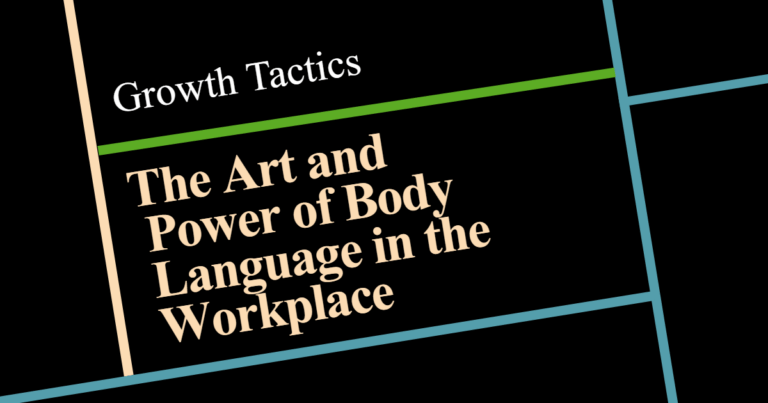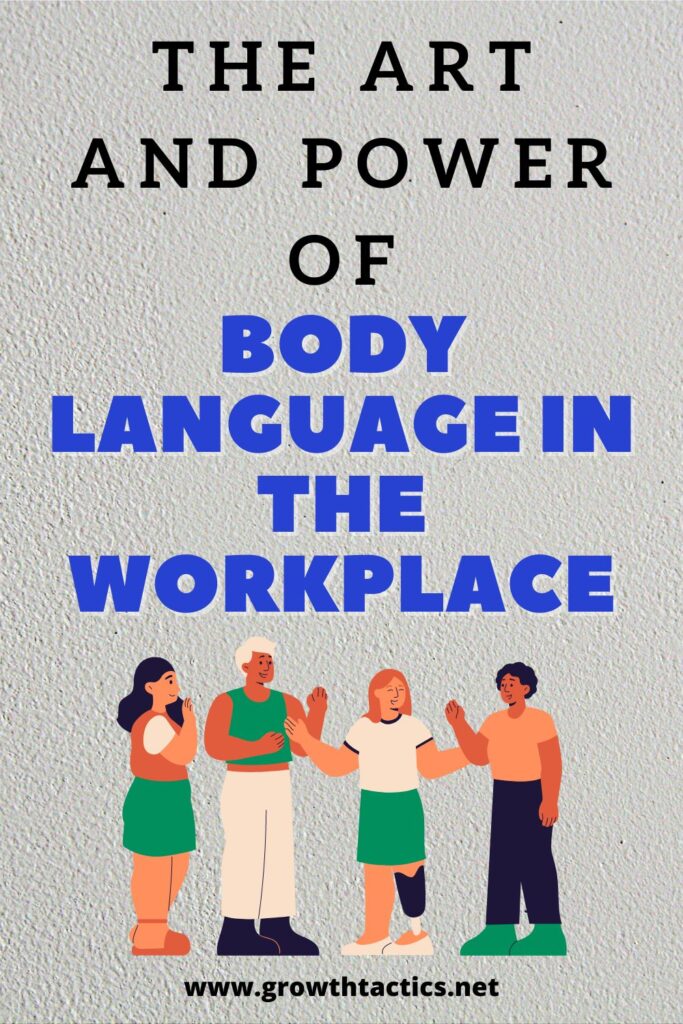Imagine walking into a room and instantly commanding respect. Picture yourself acing that job interview without saying a word. Envision leading a team meeting where everyone hangs on your every gesture. This isn’t magic. It’s the power of body language in the workplace.
Your nonverbal cues speak volumes before you even open your mouth. They can make or break deals, relationships, and careers.
In today’s competitive business world, mastering the art of body language isn’t just an option; it’s a necessity. Ready to unlock the secrets of nonverbal communication? Let’s get into the fascinating world of workplace body language and discover how it can transform your professional life.
Jump To Section
Key Components of Body Language
Your body speaks louder than words. Let’s break down the key elements of nonverbal communication:
Facial Expressions
Your face tells a story. Smile to show warmth. Frown and you’ll push people away. Practice in the mirror. Make your expressions match your words.
Eye Contact
Look people in the eye. It shows confidence and interest. Don’t stare, though. That’s creepy. Find a balance. Aim for about 60% eye contact in conversations.
Posture
Stand tall. Sit up straight. Good posture screams confidence. Slouching makes you look lazy or insecure. Pull your shoulders back. Keep your head high.
Hand Gestures
Use your hands to emphasize points. Keep gestures natural and controlled. Wild movements distract from your message. Practice gestures that feel comfortable to you.
Personal Space
Respect others’ bubbles. In most Western cultures, keep about an arm’s length away. Pay attention to how others react. Step back if someone looks uncomfortable.
Remember, these components work together. They create your overall body language. Master them, and you’ll communicate more effectively. You’ll make stronger connections at work. Your nonverbal cues will support your words, not contradict them.
Practice these elements daily. Soon, they’ll become second nature. You’ll see the difference in how people respond to you. Your workplace interactions will improve. You’ll become a more powerful communicator.

The Impact of Body Language in Professional Settings
Think about a time when you met someone new at work. Did you notice how they stood, smiled, or made eye contact? These nonverbal cues are all part of body language. It’s an important part of how we communicate in the workplace.
First Impressions Count
When you meet someone, how you stand and greet them makes a big difference. Standing tall and shaking hands firmly shows confidence and respect. Good eye contact helps build trust.
Watch Your Posture
How you sit and stand can send signals about your attitude. Slouching can make you seem uninterested, while standing or sitting up straight shows that you’re attentive and ready to engage.
Gestures Matter
When you talk, your hand movements can emphasize what you’re saying. But it’s important to use gestures in moderation. Too much movement can be distracting, while too little can make you seem stiff.
Look Them in the Eye
Making eye contact when you talk to someone shows that you’re engaged and genuine. Avoiding eye contact can make you seem unsure or dishonest, but staring can be uncomfortable. Find a balance that feels right.
Smile and Mean It
A genuine smile can help put others at ease and make them more receptive to what you have to say. But a fake smile is often easy to spot. Let your natural positivity shine through.
Respect Personal Space
Be mindful of the space between you and your colleagues. Standing too close can feel intrusive, while standing too far away might make you seem distant. Find a comfortable distance for conversation.
Find Common Ground
Mirroring someone’s body language, like their posture or gestures, can help build rapport. It shows that you are in sync with them, creating a sense of connection and cooperation.
Consistency is Key
Your body language should align with what you say. If your words and your body language don’t match, it can create confusion. Consistent nonverbal cues increase the impact of your words.
Practice Makes Perfect
Improving your body language takes practice. Pay attention to how others respond to different body cues. Practice in front of a mirror or with a friend to become more aware of your nonverbal communication.
Your body language speaks volumes in professional settings. Mastering it can improve your communication and help you build stronger connections with your colleagues. Keep these tips in mind, and watch how they can transform your professional interactions.
Common Body Language Mistakes in the Workplace
Have you ever thought about how your body language can affect your work? Your body language might be saying things you didn’t even realize! Let’s take a look at some common mistakes that you might be making without even knowing it.
1. Avoiding Eye Contact
When you don’t look people in the eye, it can make you seem unsure or untrustworthy. Look them in the eye to show that you’re engaged and interested.
2. Crossing Your Arms
Crossing your arms can send a signal that you’re closed off or defensive. Keep your arms open to show that you’re approachable and open to conversation.
3. Fidgeting Excessively
Too much fidgeting can make you seem nervous or distracted. Try to keep your movements calm and deliberate to appear more at ease.
4. Invading Personal Space
Standing too close to someone can make them uncomfortable. Respect their personal space to show that you’re considerate and respectful.
5. Slouching
Slouching can make you seem disinterested or lacking in confidence. Sit or stand up straight to show that you’re attentive and ready to engage.
6. Checking Your Phone
Constantly checking your phone during a conversation can give the impression that you’re not interested. Stay present and give your full attention to the person you’re talking to.
So, now that you know about these common negative body language mistakes, you can start making positive changes. Small adjustments in your body language can make a big difference in the way others perceive you at work. Give it a try and see the impact for yourself!
How to Improve Your Body Language
Ready to up your body language game? Here are some simple tips to help you improve how you come across at work.
1. Stand Tall and Confident
When you stand up straight and tall, it shows that you’re confident and ready to take on any challenge.
2. Smile Genuinely
A real smile can make everyone around you feel more at ease and open to what you have to say.
3. Use Open Gestures
Using open and relaxed hand gestures shows that you are approachable and interested in the conversation.
4. Make Eye Contact
Looking someone in the eye lets them know that you’re present and engaged in the conversation.
5. Mind Your Posture
Sitting or standing up straight sends a signal that you’re attentive and ready to engage with others.
6. Give Respectful Space
Being mindful of personal space shows that you’re considerate and respectful of others’ boundaries.
7. Practice Active Listening
Showing that you’re really listening by nodding and using encouraging gestures can make others feel heard and valued.
These are small changes that can make a big difference in the way you interact with others at work. Try them out and see the positive impact it can have!
Body Language in Specific Workplace Scenarios
Now that you know some general tips on improving your body language, let’s look at some specific scenarios in the workplace where body language can play a big role.
1. Job Interviews
When you go for a job interview, your body language can affect the impression you make. Make sure to sit up straight, make eye contact with the interviewer, and avoid fidgeting too much. A warm smile goes a long way in showing your enthusiasm for the position.
2. Team Meetings
During team meetings, try to use open and relaxed gestures to show that you’re open to conversation and collaboration. Make direct eye contact with your colleagues to show that you’re actively listening to their ideas and appreciating their contributions.
3. Presentations
When giving a presentation, your body language can make or break your confidence. Stand up straight, use hand gestures to emphasize key points, and make sure to make eye contact with the audience. Avoid swaying or fidgeting excessively – staying grounded will help you feel more in control.
4. Conflict Resolution
During conflicts in the workplace, your body language can either escalate or diffuse the situation. Use a calm and open posture to show that you’re willing to listen and collaborate towards a resolution. Make eye contact while speaking, and use reassuring gestures like nodding to show your empathy towards your colleague.
5. One-on-One Conversations
During one-on-one conversations, use eye contact and focused attention to engage with your colleague directly. Use open gestures to show that you’re interested in what they have to say. Try to mirror their body language to create a sense of connection.
These specific scenarios can come up frequently in the workplace. By being mindful of your body language, you can improve your communication skills and build stronger relationships with your colleagues. Give it a try – you’ve got this!
Cultural Considerations in Workplace Body Language
Understanding cultural differences in body language is crucial in a diverse workplace. Let’s explore how cultural nuances can impact communication through body language.
1. Personal Space
Different cultures have varying preferences for personal space. Respect others’ boundaries by being mindful of how close you stand or sit during conversations.
2. Gestures and Expressions
Hand gestures and facial expressions can be interpreted differently across cultures. Avoid using gestures that may be offensive or inappropriate in someone else’s cultural context.
3. Eye Contact
In some cultures, prolonged eye contact may be perceived as rude or confrontational. Be aware of how much eye contact is considered respectful in different cultural settings.
4. Posture and Positioning
Sitting positions and body posture can convey different meanings in various cultures. Pay attention to how you sit or stand to ensure you are conveying the right message.
5. Tone of Voice
The tone of voice can also differ in cultural contexts. Be mindful of the volume and intonation of your voice to avoid miscommunication or unintended offense.
6. Nonverbal Cues
Nonverbal cues such as nodding, shaking hands, or bowing can vary in significance across cultures. Take the time to learn about these customs to show respect and understanding.
By being aware of cultural differences in body language, you can navigate workplace interactions more effectively and foster a more inclusive and harmonious environment. Embrace diversity and celebrate the richness it brings to your communication skills.
The Role of Body Language in Virtual Work Environments
In virtual work environments, body language plays a vital role in communication, even though you’re not face-to-face. Let’s explore how you can use body language effectively in online interactions.
1. Facial Expressions
Your facial expressions can convey emotions even through a screen. Use smileys or emojis to show your emotions and keep your video on during virtual meetings to maintain a sense of connection.
2. Eye Contact
Maintaining eye contact is essential in virtual meetings to show active participation and engagement. Look directly at the camera when speaking to create a sense of connection with your colleagues.
3. Posture
Sitting up straight and maintaining a good posture during virtual meetings helps convey professionalism and attentiveness. Avoid slouching or moving around too much to maintain a focused presence.
4. Hand Gestures
Using hand gestures can enhance your message in virtual conversations. Keep your gestures within the frame of the camera and use them thoughtfully to emphasize key points.
5. Vocal Cues
Your tone of voice and pace of speaking can convey enthusiasm and engagement in virtual interactions. Speak clearly and vary your tone to keep your audience engaged and show your interest in the conversation.
6. Background and Environment
Your virtual background and surroundings can also influence how your body language is perceived. Choose a clean and professional background to create a positive impression during online meetings.
By being mindful of your body language in virtual work environments, you can enhance your communication skills, build stronger relationships with colleagues, and effectively convey your message. Embrace the power of nonverbal cues even in the digital world to create meaningful connections in your virtual workplace interactions.
The Connection Between Body Language and Business Administration
Did you know that body language can have a significant impact on your success in business administration? Let’s explore how mastering body language can help you excel in this role.
1. Leadership Presence
In business administration, having a strong leadership presence is crucial. Your body language can influence how others perceive you as a leader. Stand tall, maintain open and confident postures, and use purposeful gestures to project authority and inspire confidence in your team.
2. Effective Communication
Clear and effective communication is key in business administration. Your body language can reinforce your words and make your message more impactful. Maintain eye contact, use hand gestures to emphasize key points, and exhibit active listening through nods and other nonverbal signals.
3. Building Relationships
Building strong relationships is essential for success in business administration. Your body language can help foster connection and build trust with colleagues, clients, and stakeholders. Use friendly and open gestures, maintain approachable body postures, and show genuine interest in others through attentive listening and positive facial expressions.
4. Negotiation Skills
Negotiation is a common task in business administration. Your body language can greatly influence the outcome of a negotiation. Project confidence through your posture, maintain eye contact and use assertive yet respectful gestures to convey your arguments and influence the discussion.
5. Conflict Resolution
In business administration, conflicts can arise. Your body language can play a vital role in resolving conflicts diplomatically. Show empathy and understanding through open body language, active listening, and respectful gestures. Practice effective problem-solving techniques while keeping your body language positive and composed.
Mastering body language in the field of business administration can help you become a more effective leader, communicator, and relationship builder. By paying attention to your nonverbal cues, you can enhance your professional presence and contribute to the success of your organization. So, start integrating these body language skills into your business administration toolkit and watch your career soar!
Conclusion
Body language plays a critical role in workplace communication, and mastering it can give you a significant advantage in your professional life. Whether you’re leading a team, negotiating a deal, or resolving conflicts, your body language can influence how others perceive you and shape the outcome of your interactions.
By being mindful of your nonverbal cues, you can build stronger relationships, project confidence, and enhance your communication skills. Whether you’re in a physical or virtual workplace, remember to maintain good posture, use purposeful gestures, and maintain attentive eye contact and vocal cues to reinforce your message and create a meaningful connection with those around you.
As you continue to develop your professional skills, don’t neglect the power of body language. With practice and intention, you can master this important tool and take your career to the next level. So, start paying attention to your nonverbal cues and unlock the full potential of your body language today!


